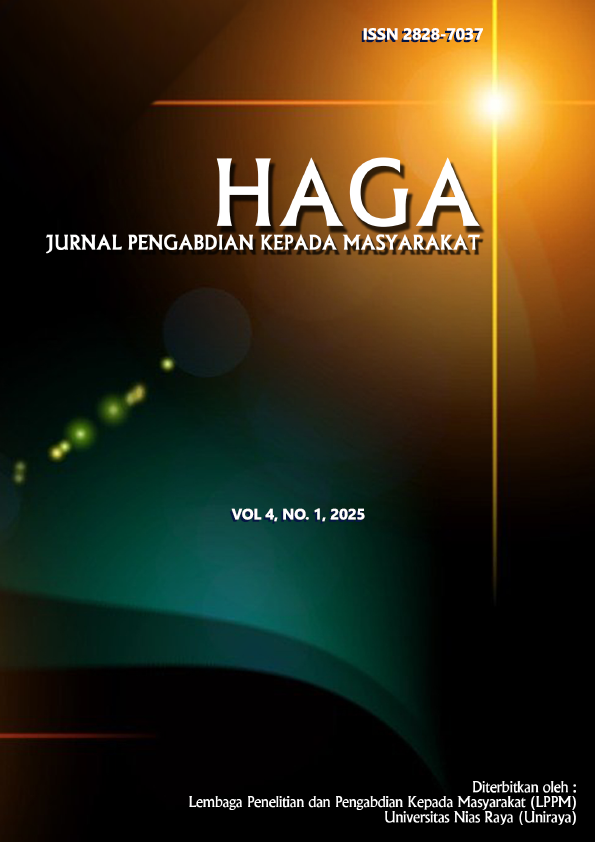PERTANIAN PADI BEBAS PESTISIDA KIMIA: EDUKASI DAN PENERAPAN PENGENDALIAN HAMA TERPADU (PHT) DI DESA BAWOZA’UA, NIAS SELATAN
Abstract
This community service program was carried out with the primary goal of enhancing the capacity and self-reliance of rice farmers in implementing the concept of Integrated Pest Management (IPM) based on environmentally friendly principles. Through this approach, farmers are expected to reduce their dependence on chemical pesticides, which have long posed potential negative impacts on health, the environment, and the ecological balance of paddy field ecosystems. The program was implemented through a seven-session workshop consisting of interactive lectures, group discussions, field demonstrations, and hands-on practice. Each session focused on improving farmers’ knowledge and practical skills, such as identifying natural pest enemies, utilizing botanical pesticides, and applying rice cultivation techniques that support IPM systems. Evaluation was conducted using a pre–post test on six indicators of knowledge and behavioral intention. The results showed a significant improvement: five out of six indicators reached a success rate above 80%, while farmers’ commitment to reducing chemical pesticide use reached 76%. These outcomes are consistent with recent literature (FAO, 2022; IRRI, 2020; Rahman et al., 2023), which highlights the effectiveness of IPM and the importance of participatory extension approaches in promoting sustainable agricultural practices. The program recommends continued mentoring, particularly in the production of botanical pesticides and the implementation of synchronized planting strategies, to strengthen the resilience of local agricultural ecosystems.
References
Amalia, A., Syaukat, Y., Hakim, D. B., & Dadang, D. (2023). Implementation of Integrated Pest Management and Non-IPM in rice plants (Case study in Kampar Subdistrict, Riau Province, Indonesia). International Journal of Progressive Sciences and Technologies, 39(2), 375–388.
Barzman, M., Bàrberi, P., Birch, A. N. E., et al. (2015). Eight principles of integrated pest management. Agronomy for Sustainable Development, 35(4), 1199–1215. https://doi.org/10.1007/s13593-015-0327-9
Damalas, C. A., & Koutroubas, S. D. (2018). Farmers’ exposure to pesticides: Toxicity types and ways of prevention. Toxics, 6(1), 1. https://doi.org/10.3390/toxics6010001
Food and Agriculture Organization of the United Nations, & World Health Organization. (2023). Report 2022: Pesticide residues in food—Joint FAO/WHO Meeting on Pesticide Residues (Evaluation Part I: Residues). World Health Organization. https://doi.org/10.4060/cc4115
Harefa, D. (2025). Improving Environmental Conservation Skills Through Science Learning That Values The Local Wisdom Of Hombo Batu In The Botohilitano Indigenous Community. Global Sustainability and Community Engagement, 1(3), 119–130. https://doi.org/10.62568/gsce.v1i3.302
International Rice Research Institute. (2020). Pest management (Rice Knowledge Bank). https://knowledgebank.irri.org/training/fact-sheets/pest-management/ knowledgebank.irri.org
Isman, M. B. (2020). Botanical insecticides in the twenty-first century—Fulfilling their promise? Annual Review of Entomology, 65, 233–249. https://doi.org/10.1146/annurev-ento-011019-025010
Kementerian Pertanian Republik Indonesia. (2023). Statistik Pertanian 2023. Pusat Data dan Sistem Informasi Pertanian.
Kogan, M. (1998). Integrated pest management: Historical perspectives and contemporary developments. Annual Review of Entomology, 43, 243–270. https://doi.org/10.1146/annurev.ento.43.1.243
Mariyono, J. (2008). Direct and indirect impacts of integrated pest management on pesticide use: A case of rice agriculture in Java, Indonesia. Pest Management Science, 64(10), 1069–1073. https://doi.org/10.1002/ps.1602
Mordue (Luntz), A. J., & Nisbet, A. J. (2000). Azadirachtin from the neem tree Azadirachta indica: Its action against insects. Annual Review of Entomology, 45, 55–66. https://doi.org/10.1146/annurev.ento.45.1.55
Ngegba, E. M., Cui, Z., et al. (2022). Use of botanical pesticides in agriculture as an alternative to synthetic pesticides. Agriculture, 12(5), 600. https://doi.org/10.3390/agriculture12050600
nternational Rice Research Institute. (n.d.). Pests and diseases (Rice Knowledge Bank). https://www.knowledgebank.irri.org/step-by-step-production/growth/pests-and-diseases knowledgebank.irri.org
Pretty, J., & Bharucha, Z. P. (2015). Integrated pest management for sustainable intensification of agriculture in Asia and Africa. Insects, 6(1), 152–182. https://doi.org/10.3390/insects6010152
Republik Indonesia. (2019). Undang-Undang Nomor 22 Tahun 2019 tentang Sistem Budi Daya Pertanian Berkelanjutan. Kementerian Sekretariat Negara.
Roubos, C. R., Rodriguez-Saona, C., & Isaacs, R. (2014). Mitigating the effects of insecticides on arthropod biological control at field and landscape scales. Biological Control, 75, 28–38. https://doi.org/10.1016/j.biocontrol.2014.01.006
Stern, V. M., Smith, R. F., van den Bosch, R., & Hagen, K. S. (1959). The integrated control concept. Hilgardia, 29(2), 81–101. (Lihat ringkasan konsep & EIL).
Thorburn, C. (2015). The rise and demise of integrated pest management in rice in Indonesia. Insects, 6(2), 381–408. https://doi.org/10.3390/insects6020381
van den Berg, H., & Jiggins, J. (2007). Investing in farmers—The impacts of farmer field schools in relation to integrated pest management. World Development, 35(4), 663–686. https://doi.org/10.1016/j.worlddev.2006.11.005








